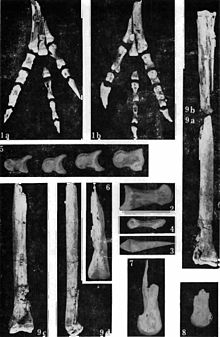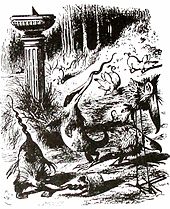| Borogovia Temporal range: Late Cretaceous, 70 Ma PreꞒ Ꞓ O S D C P T J K Pg N ↓ | |
|---|---|

| |
| Leg bones of the holotype | |
| Scientific classification | |
| Domain: | Eukaryota |
| Kingdom: | Animalia |
| Phylum: | Chordata |
| Clade: | Dinosauria |
| Clade: | Saurischia |
| Clade: | Theropoda |
| Family: | †Troodontidae |
| Genus: | †Borogovia Osmólska, 1987 |
| Type species | |
| †Borogovia gracilicrus Osmólska, 1987 | |
Borogovia is a troodontid theropod dinosaur genus which lived during the Late Cretaceous Period, in what is now Mongolia. It contains one species, Borogovia gracilicrus.
Discovery and naming

In 1971, a Polish-Mongolian expedition discovered the remains of a small theropod at the Altan Uul IV site, in the Nemegt Basin of Ömnögovĭ province. In 1982, upon describing Hulsanpes perlei, the find was reported by Halszka Osmólska and considered by her to be a possible specimen of Saurornithoides. Later she concluded that it represented a species new to science.
In 1987, Osmólska named and described the type species Borogovia gracilicrus. The generic name is derived from the fantasy creatures known as 'borogoves' in the Lewis Carroll poem "Jabberwocky" in Through the Looking-Glass. The specific name is a combination of Latin gracilis, "lightly built", and crus, "shin", in reference to the elegant build of the lower leg.
Description
The holotype specimen, ZPAL MgD-I/174, was found in the Nemegt Formation, dating from the early Maastrichtian. It consists of two lower legs of a single individual, including fragments of both tibiotarsi, the undersides of both metatarsi, and the second, third, and fourth toes of each foot.
The tibiotarsi have an estimated length of twenty-eight centimetres. Borogovia is about two meters (6 feet) long, weighing some twenty kilograms (forty-five pounds). The tibiotarsus is very elongated. The third toe is narrow. The second phalanx of the second toe is short. The claw of the second toe is short and relatively flat. Osmólska claimed that the second toe could not be hyperextended and suggested that it had regained a weight-bearing function, compensating for the weakness of the third toe. In 2021, Andrea Cau and Daniel Madzia have called this the "falchiporan condition".
Classification
Osmólska (1987) assigned Borogovia to the Troodontidae in 1987, noting that it may be a junior synonym of Saurornithoides. In the 2021 description of Tamarro, Sellés et al. recovered Borogovia as a member of the Troodontinae, closely related to Saurornithoides. Later in 2021, Cau and Madzia revised material of Borogovia and recovered it as a sister taxon to Troodontinae.
|
Sellés et al., 2021
|
Cau & Madzia, 2021
|
See also
References
- Osmólska, H., (1982), "Hulsanpes perlei n.g.n.sp. (Deinonychosauria, Saurisichia, Dinosauria) from the Upper Cretaceous Barun Goyot Formation of Mongolia", Neues Jahrbuch für Geologie und Paläontologie, Monatshefte 1982(7): 440-448
- ^ Osmólska, H., (1987), "Borogovia gracilicrus gen. et sp. n., a new troodontid dinosaur from the Late Cretaceous of Mongolia", Acta Palaeontologica Polonica 32: 133-150
- ^ Cau, A.; Madzia, D. (2021). "The phylogenetic affinities and morphological peculiarities of the bird-like dinosaur Borogovia gracilicrus from the Upper Cretaceous of Mongolia". PeerJ. 9: e12640. doi:10.7717/peerj.12640. PMC 8656384.
- ^ Sellés, A. G.; Vila, B.; Brusatte, S. L.; Currie, P. J.; Galobart, A. (2021). "A fast-growing basal troodontid (Dinosauria: Theropoda) from the latest Cretaceous of Europe". Scientific Reports. 11: 4855. doi:10.1038/s41598-021-83745-5. PMC 7921422.
| Troodontidae | |||||||||||||||||||||
|---|---|---|---|---|---|---|---|---|---|---|---|---|---|---|---|---|---|---|---|---|---|
| |||||||||||||||||||||
| |||||||||||||||||||||
| Taxon identifiers | |
|---|---|
| Borogovia | |
This theropod-related article is a stub. You can help Misplaced Pages by expanding it. |
